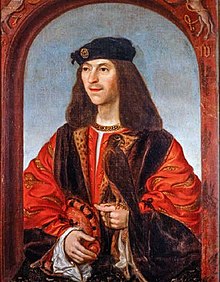
Back Jakobus IV van Skotland Afrikaans Chaime IV d'Escocia AN Iacobus IV Scotta Cyning ANG جيمس الرابع ملك إسكتلندا Arabic جيمس الرابع ملك اسكتلندا ARZ IV Ceyms (Şotlandiya kralı) Azerbaijani دؤردونجو جیمز (ایسکاتلند) AZB Джеймс IV (Шотландия) Bulgarian Jakov IV, kralj Škota BS Jaume IV d'Escòcia Catalan
| James IV | |
|---|---|
 James IV, copy by Daniël Mijtens of a lost contemporary portrait.[1] | |
| King of Scotland | |
| Reign | 11 June 1488 – 9 September 1513 |
| Coronation | 24 June 1488 |
| Predecessor | James III |
| Successor | James V |
| Born | 17 March 1473 Stirling Castle, Stirling, Scotland |
| Died | 9 September 1513 (aged 40) Branxton, Northumberland, England |
| Spouse | |
| Issue more... | |
| House | Stewart |
| Father | James III of Scotland |
| Mother | Margaret of Denmark |
| Signature |  |
James IV (17 March 1473 – 9 September 1513) was King of Scotland from 11 June 1488 until his death at the Battle of Flodden in 1513. He inherited the throne at the age of fifteen on the death of his father, James III, at the Battle of Sauchieburn, following a rebellion in which the younger James was the figurehead of the rebels. James IV is generally regarded as the most successful of the Stewart monarchs. He was responsible for a major expansion of the Scottish royal navy, which included the founding of two royal dockyards and the acquisition or construction of 38 ships, including the Michael, the largest warship of its time.[2]
James was a patron of the arts and took an active interest in the law, literature and science. With his patronage the printing press came to Scotland, the University of Aberdeen and the Royal College of Surgeons of Edinburgh were founded, and he commissioned the building of the Palace of Holyroodhouse and Falkland Palace. The education act passed by the Parliament of Scotland in 1496 introduced compulsory schooling. During James's twenty-five-year reign, royal income doubled, the Crown exercised firm control over the Scottish church, and by 1493 had overcome the last independent Lord of the Isles. Relations with England improved with the Treaty of Perpetual Peace in 1502 and James's marriage to Margaret Tudor in 1503, which led to the Union of the Crowns in 1603.
The long period of domestic peace after 1497 allowed James to focus more on foreign policy, which included the sending of several of his warships to aid his uncle, John of Denmark, in his conflict with Sweden; amicable relations with the Pope, Holy Roman Emperor Maximilian I and Louis XII of France; and James's aspiration to lead a European naval crusade against the Turks of the Ottoman Empire.[3] James was granted the title of Protector and Defender of the Christian Faith in 1507 by Pope Julius II.
When Henry VIII of England invaded France in 1513 as part of the Holy League, James chose the Auld Alliance with the French over the "Perpetual Peace" with the English, and led a large army across the border into England. James and many of his nobles were killed at the Battle of Flodden on 9 September 1513, fighting against the English forces of Catherine of Aragon, Henry VIII's wife and regent. James was the last monarch in Great Britain to be killed in battle and was succeeded by his son James V.
- ^ Henry VIII owned a "picture of Jacobe kinge of Scottes with an hawke on his fist", Maria Hayward, The 1542 Inventory of Whitehall Palace, 2 (Illuminata Press, 2004), p. 96 no. 799.
- ^ T. Christopher Smout, Scotland and the Sea (Edinburgh: Rowman and Littlefield, 1992), ISBN 0-85976-338-2, p. 45.
- ^ Gosman, MacDonald & Vanderjagt 2003, p. 151.